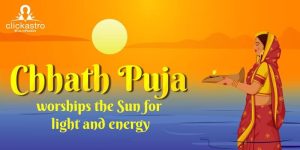Contents[hide]
When is Onam celebrated?
The festival of Onam lasts more than ten days. It is celebrated in the month of Chingam (Simha), which is the first month in the traditional Malayalam solar calendar. The festival extends from Atham (Hasta) Nakshatram to Chathayam (Shatabhisha) Nakshatram in the month of Chingam. The celebrations will be in full splendor on Uthradam (Uttara Ashada), Thiruvonam (Sravana), Avittom (Dhanishta), and Chathayam (Shatabhisha), which are generally regarded as Onnaam (First) Onam, Randaam (Second) Onam, Moonnam (Third) Onam and Naalaam (Fourth) Onam respectively. The most important day of the festival is Thiruvonam. The festival name ‘Onam’ itself is a tweak of the word Thiruvonam. On the Gregorian calendar, Onam usually falls in late August or early September.When is Thiruvonam 2024?
Thiruvonam 2024, the most important occasion of the festival of Onam, falls on September 15, Sunday. So the festival date of Onam in 2024 is September 15. Atham, the day marking the beginning of celebrations, falls on September 6, Friday.Festival Date of Onam in 2024 is September 15
Onam 2024 – Important Dates and Timings
Sunrise: September 15, 2024 6:18 AM
Sunset : September 15, 2024 6:21 PM
Thiruvonam Nakshathram Begins: September 14, 2024 8:32 PM
Thiruvonam Nakshathram Ends: September 15, 2024 6:49 PM
| Nakshatra | Date | Weekday |
| Atham (Hasta) | September 06 | Sunday |
| Chithira (Chitra)/Chothi (Swati) | September 07 | Monday |
| Chodi (Swati) | September 08 | Tuesday |
| Visakham (Visakha) | September 09 | Wednesday |
| Anizham (Anuradha) | September 10 | Thursday |
| Thrikketta (Jyeshta) | September 11 | Friday |
| Moolam (Moola) | September 12 | Saturday |
| Pooradam (PurvaAshada) | September 13 | Sunday |
| Uthradam (UtharaAshada) | September 14 | Monday |
| Thiruvonam (Sravana) | September 15 | Tuesday |
| Avittam (Dhanishta) | September 16 | Wednesday |
| Chathayam (Shatabhisha) | September 17 | Thursday |
Onam 2024: Cultural Significances
Onam, the biggest festival in the state of Kerala, fills the hearts of people with gaiety and brings them together to be a part of the vibrant, cultural festival. All Keralites, their families, neighborhoods, and even the public and private organizations try to make the celebrations as grand as they can. Every year, the Govt. Of Kerala declares a 4-day holiday break to celebrate Onam. The four days are the First (Uthradam), Second (Thiruvonam), Third (Avittam), and Fourth (Chathayam) Onam days. Thiruvonam, the second Onam, is the main day that is celebrated with the most pomp and splendor. It is the most important festival that fills up gaiety in every nook and corner of the land. The celebrations range from families buying new clothes and feasting together to large social events showcasing various cultural and sports entertainments.Mahabali
For Keralites, the Onam celebrations are a commemoration of the legendary King Mahabali. It is believed that during the reign of Mahabali, affluence, and righteousness prevailed all over this land, and Onam is a remembrance of that beautiful period. The common belief is that every year, on the day of Thiruvonam, Mahabali visits his land and people from PatalLoka (nether world). Some associate this festival with the birth of Vishnu’s fifth avatar Vamana.Harvest festival of Kerala
Onam is also the rice harvest festival of Kerala. It falls at that time of the year when the monsoon takes a break. The weather will be perfect, neither too dry nor too wet, and the flowers will be in full bloom. The various customs and celebrations observed on the occasion of Onam are symbolic of agricultural prosperity and overall social affluence. Onam is the most important festival of the Hindus in Kerala, but this occasion is enjoyed by other communities too. The grand celebrations of this festival eliminate all the religious disparities in society. It is a common practice for the other communities here to join the Hindus in their traditional Onam feast and other merrymaking. It unites people of all communities and spreads the message of peace and harmony.Onam celebrations
All the celebrations associated with Onam are a display of Kerala’s rich heritage and culture. Various post-harvest sports, Onapattukal (Onam songs), Kaikottikkali, and all other cultural and entertainment programs depict the beauty and pride of a great tradition. This time of the year is also considered the tourism week in Kerala and is the best time to visit the state. All the shops and commercial establishments in the state enjoy maximum business in this period of the year.The Legend of Onam
The history of Onam dates back to the Sangam period when it was used to be celebrated for a month. According to mythology, the demon King Mahabali (grandson of Prahlad), a mighty ruler, controlled the three Lokas – BhuLoka, Deva Loka, and PatalLoka (Earth, Heaven, and the Nether World). Even though he belonged to the Asura clan, he was known to be generous and kind to his people, and for that, he was adored. It was during his reign that people saw the best of times; prosperity and grandeur ruled everywhere. However, the Gods were unhappy with him because he had defeated them, and his power and popularity kept growing. Hence, they approached Lord Vishnu for help.Vamana and Mahabali
Sensing their concern, Lord Vishnu disguised himself as a poor Brahmin Vamana and visited the king. Vamana asked Mahabali to grant him the land which he can cover with three feet. Being a kind and charitable person, Mahabali granted his wish, and soon Vamana started to grow huge in size. As he covered the Earth and Heaven with his first two steps, King Bali asked him to keep his last step on his head which lead him to Patala (nether world). However, for the good deeds of King Bali, Lord Vishnu granted him the boon to visit his people annually, which led to the celebration of the Onam festival. So, Onam celebrates the homecoming of King Mahabali.Rituals of Onam Festival
Following are some traditions/practices commonly followed as part of Onam celebrations.Pookkalam: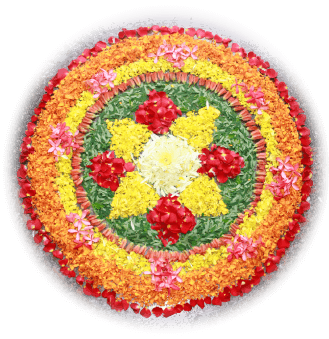
Also known as Athapookkalam, these are the artistic floral designs laid on the ground, usually in front of the house. Generally, on the day of Atham, the womenfolk of the family dressed up in traditional styles, collect flowers, and arrange the patterns. Nowadays, conducting Athapookkalam events is a common practice in which both men and women participate in large numbers.
Onakkodi:
The new clothes that people gift to their dear ones on the occasion of Onam.Onasadya / Onam Sadya:
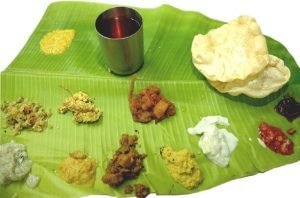 The traditional Kerala feast is served on banana leaves. Meals with more than 13 traditional dishes, including chips, pickles, and papads, are prepared for this. Payasam, a characteristic sweet dish made of rice, milk, sugar, and coconut, is a must for Onasadya.
The traditional Kerala feast is served on banana leaves. Meals with more than 13 traditional dishes, including chips, pickles, and papads, are prepared for this. Payasam, a characteristic sweet dish made of rice, milk, sugar, and coconut, is a must for Onasadya.
Vallamkali:
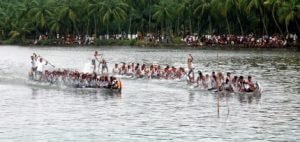 This is the traditional Kerala boat race event, usually conducted on the occasion of Onam. Long wooden boats called Chundanvallam(Snake boats), rowed by hundreds of oarsmen, compete with each other, and the winners get huge amounts of cash as rewards.
This is the traditional Kerala boat race event, usually conducted on the occasion of Onam. Long wooden boats called Chundanvallam(Snake boats), rowed by hundreds of oarsmen, compete with each other, and the winners get huge amounts of cash as rewards.

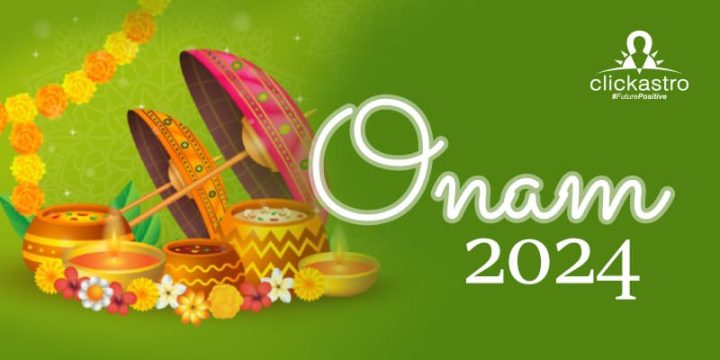

 Pulikkali:
Pulikkali:


